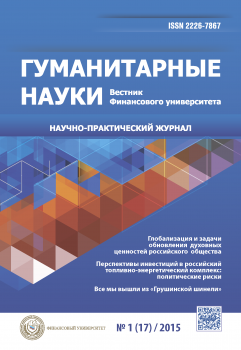Article contains the analysis of approaches to measurement of poverty in various foreign countries including as being members of the European Union, and isn’t present; it is told about possibility of loan of experience of measurement of poverty by the countries — not only members of the European Union. Article reveals interrelation of the program of the UN (PROON), concerning rating of the countries of the world on the level of human development with economic and social situation of the countries, one of which main directions is the standard of living (the gross national income per capita calculated at purchasing power). Level of wellbeing of the person is also defined with such indexes as: Index of a gender inequality, Index of multidimensional poverty, Index of a social and economic inequality. Following the results of 2013 Russia took the 57th place in a rating and treats the countries with a high level of development of human potential. In our country steady positive dynamics in all directions is noted. As for Europe, in article the opinion of experts on which to reduce quantity poor several times for only some years and even in the conditions of the proceeding financial and economic crisis is noted is extremely problematic. The greatest threat to wellbeing of Europeans is posed by so-called monetary poverty. The indicator of monetary poverty displays number of citizens which real income is lower than 60% of average value about the country. In Europe consider that such level of poverty guarantees a physiological survival. Actual experience of measurement and technologies of overcoming of poverty of such foreign countries as Germany, Denmark, Sweden, Denmark and other countries is considered. In article importance of exchange of experience between the countries, as not entering into the European Union, and European Union member countries is emphasized; need of further improvement of techniques of measurement of poverty, development and improvement of indicators of poverty, and also technologies of its overcoming.
absolute approach, index of human development, monetary approach, poverty level, poverty line, poverty, social policy, technologies of measurement of poverty.
Статья подготовлена в рамках государственного заказа 2014 г. на тему «Социальные последствия бедности в России: измерение и технологии сокращения».
Программа развития ООН (ПРООН) в ежегодном докладе о развитии человеческого потенциала представила рейтинг стран мира по уровню человеческого развития. Индекс развития человеческого потенциала (ИРЧП) является агрегированным показателем социально-экономического положения стран по трем основным направлениям: долголетие (оценивается ожидаемая при рождении продолжительность жизни), доступ к знаниям (анализируется средняя и ожидаемая продолжительность обучения) и уровень жизни (в качестве показателя используется валовой национальный доход на душу населения, рассчитанный по паритету покупательной способности).
С 2010 г. ИРЧП корректируется с учетом индекса социально-экономического неравенства, индекса гендерного неравенства, а также индекса многомерной бедности. ИРЧП позиционируется ООН в качестве востребованного индикатора, позволяющего более точно по сравнению с традиционными показателями, в основе которых лежит объем ВВП, оценить уровень благополучия человека.
По итогам 2013 г. Россия заняла в рейтинге 57 место и относится к странам с высоким уровнем развития человеческого потенциала [1, с. 163]. В России отмечена устойчивая положительная динамика по всем направлениям.
В Европе дела обстоят намного сложнее. Статистическое агентство Евросоюза «Eurostat» высказывает сомнения в серьезности обещаний европейских политиков снизить уровень бедности в их странах к 2020 г. до 20 млн человек. Эксперты утверждают, что сократить количество бедных в несколько раз всего за несколько лет, да и еще в условиях продолжающегося финансово-экономического кризиса, крайне проблематично.
1. Human Development Report 2014. Sustaining Human Progress: Reducing Vulnerabilities and Building Resilience, 234 pages. Available at: http://hdr.undp.org/sites/default/files/hdr14-report-en-1.pdf (Accessed: 10 December 2014).
2. The Eurozone economy resumed growth. BBC News Russian service. Available at http://www.bbc.co.uk/russian/business/2014/02/140214_eurozone_gdp_growth (Accessed: 10 December 2014).
3. Report of the Economic and Social Council for the year 2010. The United Nations. Available at: http://www.un.org/ru/ecosoc/docs/session_docs_2010.shtml (Accessed: 10 December 2014).
4. Development Co-operation Report 2013 ENDINGPOVERTYOECD Publishing 2013 (the Report on cooperation in development for 2013: to eradicate poverty). Available at: http://eudevdays.eu/sites/default/files/185114356-Development-Co-operation-Report-2013-Ending-Poverty-Highlights.pdf (Accessed: 10 December 2014).
5. Doklad o chelovecheskomrazvitii v Rossiyskoy Federatsii 2013. Ustoychivoe razvitie: vyzovy Rio[The human development report in the Russian Federation 2013. Sustainable development: challenges Rio]. Available at: http://www.undp.ru/documents/NHDR-2013.pdf(Accessed: 10 December 2014).
6. Novaya evropeyskaya bednost´ [New European poverty]. Ekspert [Expert]. No. 49 (733). Available at: http://m.expert.ru/expert/2010/49/novaya-evropejskaya-bednost (Accessed: 10 December 2014).





